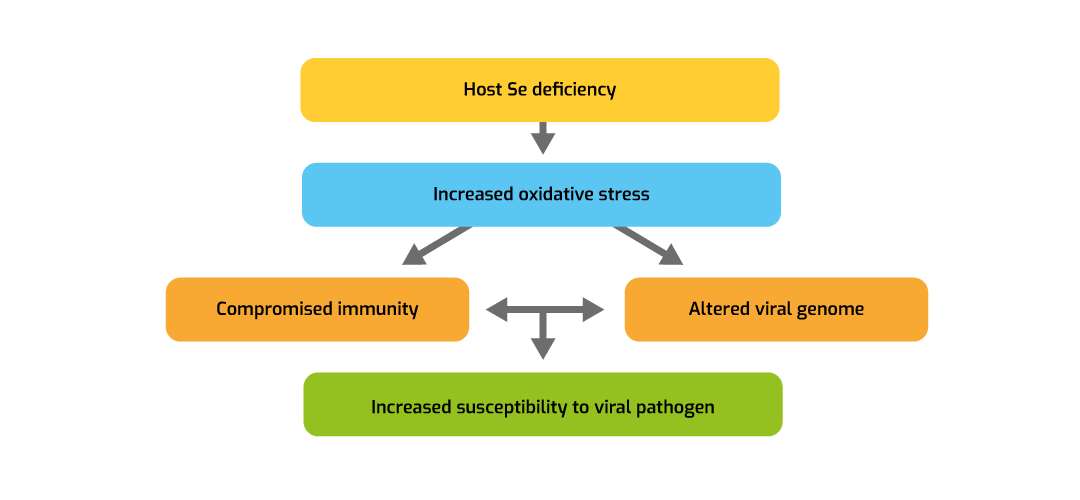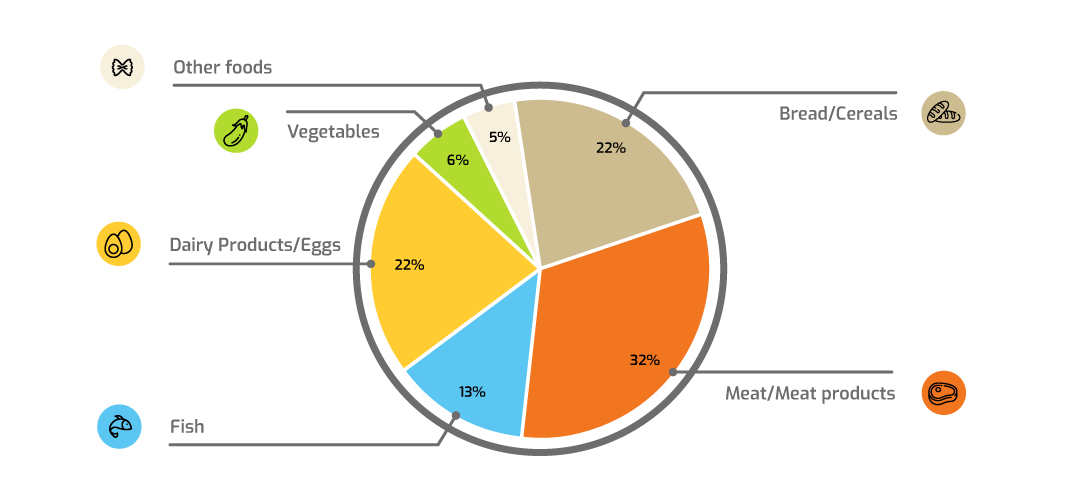


A balanced diet is key for human health promotion. Among essential nutrients Selenium is shown to be deficient in many countries worldwide.
In animals as well as in humans, Selenium deficiency is associated with a compromised immunity and increased susceptibility to various diseases including the recent epidemic caused by COVID 19.
Production of Se-enriched eggs, meat and milk could be an important approach to deal with human Selenium deficiency.

Prof Peter SURAI
Feed-Food Ldt, UK

Dr. Michele DE MARCO
GlobalScientific and Technical Manager
ADISSEO
Many centuries ago, Hippocrates’ observations on the relationship between health and nutrition led to the beginning of a discussion about the factors that influence our health.
However, over the last few decades, it has become obvious that although our lifestyle, with reference to our diet, stress, smoking, medical attention, exercise and genetics, is a major determinant of our health status, our diets also play a pivotal role. Nutritional practices in most developed countries have recently changed the focus from fighting nutrient deficiencies to addressing nutrient requirements in order to maintain good health throughout ones’ life.
However, people do not all consume the same food, and they meet their nutritional needs in many and various ways. Food is the major source of micronutrients and natural antioxidants, including vitamin E, vitamin C, carotenoids, flavonoids, selenium (Se), etc.
It is necessary to take into account that all antioxidants in the body play very important functions and are key to maintaining the redox balance of the body, to preventing oxidative stress and to maintaining good health status, all of which help to prevent disease.
The main antioxidants in the body work as a “team”, which is responsible for antioxidant defense.
In this team, which is better known as the antioxidant system, Se, in the form of selenoproteins, plays a pivotal role and has been defined as the “chief executive” of antioxidant defense.
Deficiencies of micronutrients, including essential trace elements, affect up to 3 billion people worldwide.
The dietary availability of trace elements is determined to a great extent by their soil concentrations. One such micronutrient is Se, and up to 1 in 7 people are affected by an inadequate dietary intake of Se, which is also known to affect the health of livestock.
The main problem with Se nutrition is the great variability of Se concentrations in various foods, which is directly correlated to the Se concentration in the soil where crops and vegetables are grown, and livestock are raised.
Furthermore, the availability of Se to plants depends on many factors, including the soil pH, the oxidation-reduction potential and the mineral composition of the soil, the artificial fertilization rate and rainfall. Since the Se content in plant and animal-based feeds depends on its availability in the soil, the level of this element in human foods varies to a great extent from region to region.
In this regard, higher levels of rainfall and lower soil pH have been predicted, due to the ongoing climate change, thereby increasing the likelihood of a poor Se status for both livestock and humans.
A climate change projection has recently predicted future global Se soil losses in which 66% of croplands could lose up to 8.7% of Se. These losses will further increase the worldwide deficiency of Se.
The World Health Organization (WHO), USDA and EFSA have recommended a human dietary intake of Se of 55–85 μg/day for adults (the EU Recommended Dietary Allowance – RDA of Se is 55 μg/day, while the USA RDA varies from 55 up to 70 μg/day for various categories of people;.
Selenium deficiency and a low daily Se dietary intake can cause endemic diseases or other significant environmental health problems, such as Keshan disease (a degenerative heart disease frequently observed in Keshan, China) and Kaschin–Beck disease (a form of osteoarthropathy that causes deformity of the joints). The daily dietary intake rate of Se varies considerably between countries/regions.
Se deficiency has been reported in parts of China (Keshan disease areas), Saudi Arabia, the Czech Republic, Burundi, New Guinea, Nepal, Croatia and Egypt for daily Se intake rates <30 μg/day.
In addition, many other countries, such as India, Belgium, Brazil, the UK, France, Serbia, Slovenia, Turkey, Poland, Sweden, Germany, Spain, Portugal, Denmark, Slovakia, Greece, the Netherlands, Italy, China, Austria and Ireland, have been identified as having Se deficient areas, because the daily Se intake levels are below the WHO recommended amount of 55 μg/day.
About 76% of the countries throughout the world are located in Se-deficiency regions, where the daily Se intake level is lower than 55 μg/day for adults.
Selenium is an essential element for humans and animals in order to have adequate bodily functions.
The beneficial effects of Se on health are well known, and they include the protection of body tissues against oxidative stress, the maintenance of defense against infection by modulating the immune and inflammatory responses of the body, the modulation of growth and development, as well as having possible anti-carcinogenic properties.
Se deficiency is associated with a decreased expression of various selenoproteins in human tissues, which in turn affects the major metabolic processes, including antioxidant defense and redox homeostasis, and these are major factors that are involved in the immunocompetence and prevention of different diseases.
Therefore, an extreme Se deficiency is associated with the development of Keshan disease and Kashin-Beck disease. Furthermore, a low Se status of the general population is believed to increase the risk of developing cancer, cardiovascular disease (CVD), Alzheimer’s, cognitive decline/dementia, thyroid autoimmune disease, problematic fertility/reproduction, rheumatoid arthritis and a variety of other diseases.
An insufficient dietary selenium intake has also been shown to impair immune competency, to reduce defense against various viral and bacterial diseases and to diminish the resistance to toxic heavy metals.
The information that has been accumulated actively over the last 20 years indicates that Se is among the major immunomodulating agents.
Selenium affects all the components of the immune system, including the development and expression of natural nonspecific and specific humoral and cell-mediated responses.
In general, a deficiency in Se appears to result in immunosuppression, whereas an optimal Se supplementation appears to result in augmentation and/or restoration of the immunologic functions.
In fact, a deficiency in Se has been shown to inhibit resistance to microbial and viral infections, to compromise the neutrophil function, antibody production, and the proliferation of T and B lymphocytes in response to mitogens, and cytodestruction from T lymphocytes and NK cells.
The relationship between nutrition and viral infection has also been studied.
It seems likely that a deficiency in Se could be an important factor in the increased susceptibility of animals and humans to viral and bacterial diseases.
Indeed, as a result of Se deficiency, the consequent high production of reactive oxygen species (ROS) and increased oxidative stress of a host can lead to an increased virus mutation rate ( Figure 1), which in turn can result in the emergence of viral pathogens with new pathogenic properties.
Therefore, Se deficiency is associated with a mutation of the viral genotype, whereby a virus can be converted from a benign strain to a highly virulent one.
Such RNA viral mutations have been reported to be faster and longer-lived in Se-deficient individuals than in healthy ones both in animals and humans.

Figure 1. Effects of Se on viral diseases
As mentioned above, viral infections normally compromise antioxidant defense by simultaneously increasing the generation of ROS with downregulation of the biosynthesis of antioxidant enzymes in the infected cell.
Some of the viruses that are associated with ROS production are the human immunodeficiency virus (HIV), the hepatitis B virus (HBV), the hepatitis C virus (HCV), the Epstein-Barr virus (EBV), herpes simplex virus type 1 (HSV-1), the vesicular stomatitis virus (VSV), the respiratory syncytial virus (RSV), human T cell leukaemia virus type 1 (HTLV-1) and influenza viruses.
Immune responses are intimately linked to inflammatory processes, and these in turn are inter-related to the production of ROS and redox control processes.
Furthermore, viral infections are often correlated with macronutrient and micronutrient deficiencies.
In fact, a selenium deficiency is common among patients infected with viruses.
For example, ROS production can increase the expression of inflammatory cytokines through an increased NF-κB activity, and it seems likely that Se modulates inflammatory and immune processes through redox functions.
An excessive body production of ROS causes damage of all biological molecules, including polyunsaturated fatty acids, proteins and DNA, thus causing protein aggregations and gene expressions errors.
For example, coxsackievirus is an enterovirus that causes Keshan disease.
Evidence suggests that Se supplementation could prevent the development of Keshan disease by enhancing viral immunity and by preventing genetic adaptations in the viral genomic RNA, which together result in a reduced virulence and cardiac pathology.
Heart damage has been observed in animal studies upon infection with a non-cardiovirulent strain of coxsackievirus B, albeit only in Se-deficient mice, whereas mice fed Se-adequate diets showed no evidence of such heart damage.
This deficiency was reflected in a higher viral load on the heart of the Se-deficient mice as well as in a lower antigen-specific T-cell response, compared to that of the Se-adequate littermates.
In fact, benign forms of both Coxsackievirus B3 (CVB3) and influenza virus type A can rapidly mutate to virulence in hosts with an Se-deficient status. Similarly, a recent study has demonstrated that Se supplementation in chickens challenged by a low pathogenicity avian influenza virus (H9N2) increases the expression of antiviral response genes, which can lead to a reduction of virus shedding from infected birds.
A large number of micronutrients in the diet, including Se, play a fundamental role in maintaining an “optimal” immune response. As a component of selenoproteins, Se is required for the effective functioning of the main immune cells, including neutrophils, macrophages, NK cells and T lymphocytes.
A high intake of selenium may help relieve oxidative stress and prevent an uncontrolled immune and inflammatory response.
An epidemic caused by a novel coronavirus (COVID-19 or SARS-CoV-2) belonging to the same group of β-coronaviruses as the severe acute respiratory syndrome (SARS) that appeared in 2002 and in the Middle East Respiratory Syndrome (MERS), is currently spreading throughout the world and threating human health and the world’s economy.
The occurrence, development, duration and severity of SARS-CoV-2 have been shown to depend on the interaction between the virus and the individual’s immune system.
SARS-CoV2, just like other RNA viruses [4], can probably trigger oxidative stress and this in turn leads to an elevated and uncontrolled production of ROS, which seems to cause a cytokine storm, that is, a deadly uncontrolled systemic inflammatory response resulting from the release of large amounts of pro-inflammatory cytokines and chemokines from immune effector cells during SARS-CoV2 infection, and with hyper inflammation in patients affected by SARS-CoV2.
As elderly people and people suffering from various diseases, including diabetes, hypertension and cardiovascular diseases, are already in a state of oxidative stress, such a viral infection will increase this stress, and this is one possible explanation of the severity of COVID-19 in these categories of patients.
At present, there is no effective treatment for SARS-CoV-2, but high immunocompetence is considered to be the most important contributor to decreasing the risk of this disease.
In this regard, an optimal nutritional status is of paramount importance and various nutritional deficiencies increase the risk of SARS-CoV-2.
In fact, a Se dietary deficiency is considered to be an important risk factor for SARS-CoV-2 infection and for the outcome of the therapies.
The effect of the Se status on the cure rates of COVID-19 has recently been shown in China. Indeed, a significant association between cure rate and background selenium status in cities outside Hubei (R2 = 0.72, F test P < 0.0001) has been reported.
Another similar study, carried out in Germany, reported that patients suffering from COVID-19 display a deficiency in the essential trace element Se in their blood, together with low concentrations of the Se transporter selenoprotein P (SELENOP) and low enzymatic activity of the secreted selenoprotein glutathione peroxidase 3 (GPx3).
This Se deficiency was found to be particularly marked in comparison with healthy European adults, and it was concordantly reflected in relatively depressed readings of all three of the different determined Se status biomarkers.
The observation that Se deficiency is more severe in the samples obtained from non-survivors than those from the survivors of COVID-19 may suggest some relevance of Se in coping with the virus and for a successful convalescence.
Several potential options are available to improve the intake of selenium by humans.
These include direct supplementation, in tablet form (as inorganic salts, but the most common supplement uses high-Se yeast that contains SeMet and some other organic selenocompounds), soil fertilization, the supplementation of staple foods, such as flour, and the production of Se-enriched functional foods, such as Se-enriched eggs, meat and milk.
Several important factors should be considered when choosing the best food supplementation strategy for a given population.
In general, the main sources of dietary Se differ from country to country.
For example, in the UK, meat and meat products provide 32% of the required daily consumption of Se, and dairy products and eggs are responsible for 22% (Figure 2).

Figure 2. Estimated intake of Se from different foods in the UK in 1997.
On the other hand, about 50% of the Se in the diet in Russia originates from bread and cereals, while meat, milk and eggs provide about 20%, 10% and 5% of the daily Se consumption, respectively.
White bread, pork, chicken and eggs account for half of the Se in the diet in the USA. Meat and meat products (30%), bread and rolls (24%), fish/fish products (11%), and milk and yoghurt (9%) are the main contributors to the mean daily Se intake in Ireland.
Fish makes the largest contribution to dietary Se intake in alpine communities in Japan (48% of the daily total), and this is followed by eggs (24%) and meat (17%).
Fish accounts for 58% of the total daily Se intake in coastal communities, followed by meat (18%) and eggs (16%). In both districts, the total contribution of rice and wheat products is around 10%.
Among the animal-derived products, Se-enriched eggs are ideally suited to meet the daily requirements, as they are an important source of Se for the general population for the following reasons:
Before the advent of commercially available organic selenium for animal diets, the main problem, as regards the enrichment of eggs with selenium, was the low transfer efficiency of inorganic selenium (the selenite or selenate forms) to the egg. In fact, even high doses of selenite in the diet of laying hens were not able to substantially enrich eggs with this trace element. It is interesting to note that practically all of the Se-enriched egg brands are produced using organic selenium as the major source of Se for laying hens at a level of 0.3-0.5 mg/kg in the feed.
Se-enriched eggs, as a rule, contain up to 30 µg Se per egg.
Since the maximum safe dietary Se intake (average NOAEL: ‘no observed adverse effect level’) is 819 µg, in order to have any detrimental effect from a Se overdose, it would be necessary to consume more than 25 eggs a day for a long period of time.
If we take into account the maximum safe dietary intake of Se identified by the Food and Nutrition Board (2000), that is, of 400 µg, it would be necessary for a person to consume 13 eggs a day for a long period of time, a situation that is difficult to imagine.
Fewer than one egg per day is generally consumed in most European and other developed countries, and the safety margin in such a condition is more than 10-fold.
Observations of Se-egg production in various countries indicate the following:
There are great prospects of an increased production of Se eggs worldwide. However, an important limitation to the production of Se-eggs is a lack of public knowledge concerning the beneficial effects of Se in relation to animal and human health. Indeed, the companies that produce Se-eggs should invest more in educating the public in order to widen the market for Se-eggs.
Various types of meat (pork, beef and chicken meat), as well as milk and milk products are also important natural sources of Se in human nutrition. However, the Se concentration in meat varies substantially, depending on the geographical origin of the country and the Se supplements used. Indeed, it is well known that selenite or selenate dietary supplementation is not effective in increasing the Se concentration in meat, and only organic Se, in the form of SeMet, in the diets of chickens, pigs or cattle, can substantially increase the Se concentration in meat.
It has been shown that when organic Se is used at a dosage of 0.3-0.5 mg/kg in the diet of chickens, pigs and cattle, it is possible to produce meat containing at least 25-30 μg/g (100 g meat can provide >50% RDA). There is also substantial evidence that organic Se in the diets of dairy cows, goats and sheep can also help produce Se-enriched milk and milk products (milk powder, cheese, yoghurt etc).
Therefore, using organic Se in livestock diets offers a great opportunity of improving the Se status of the general population and of bringing it up to the RDA levels.
Indeed, most diets already contain at least 50% RDA selenium, and, the global problem of Se deficiency could be solved by adding eggs, meat or milk and milk products enriched with Se to the daily diets of people. This would help to improve the antioxidant status and immunocompetence of the general population and increase resistance to various pathogens/diseases. However, such benefits still require further support from medical institutes.
In conclusion, it should also be mentioned that the usage of organic Se in livestock diets would enhance the health of mankind as a whole, while, at the same time, lead to economic and welfare benefits in livestock production, in terms of a better animal disease resistance, improvement and/or maintenance of the productive and reproductive performances of animals reared under stressful commercial egg, meat and milk production conditions.
Moreover, there are also indications that product quality can also be improved, as a result of Se enrichment, in terms of quality traits, freshness and shelf-life.
Therefore, the organic Se concept in livestock production could become a holistic approach to avoid the risk of worldwide Se deficiencies and lead to different and diversified benefits being obtained from farm to fork, with free-of-charge investments.
Indeed, the diet cures more than the lancet.
Reference available upon request